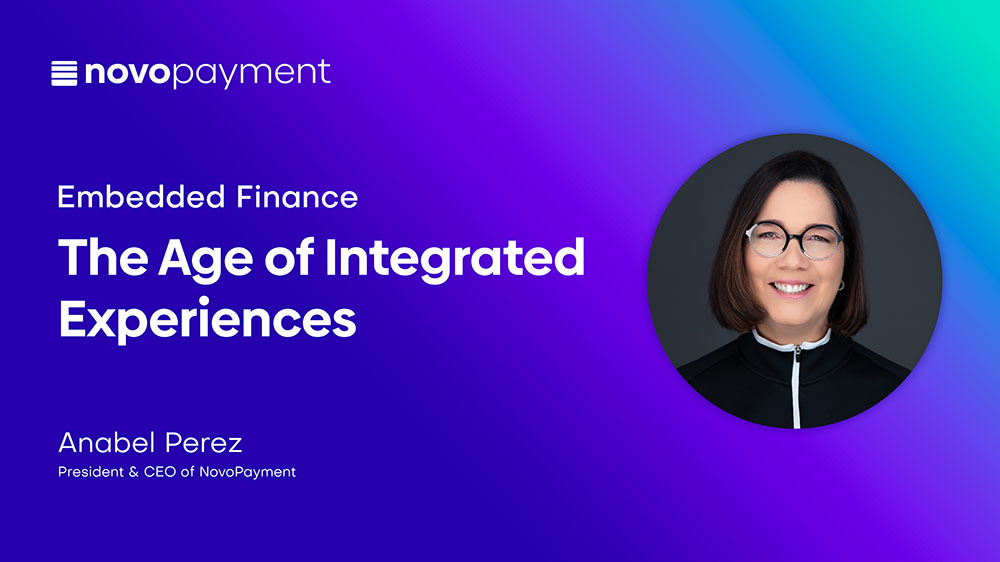Embedded Finance – The Age of Integrated Experiences

Anabel Perez, President & CEO of NovoPayment
Last week, I had the opportunity to present at Fintech Nexus LatAm here in Miami on a relevant and timely topic, embedded finance, and I wanted to take a moment to expand on some of the main points that were discussed.
The title of the panel, “Bringing Personalized Banking to the Masses,” begins to tell the story of embedded finance and its role in the future of financial infrastructure, but, while it’s one important benefit it can offer, personalized banking only begins to scratch the surface of all that embedded finance can make possible.
What is embedded finance?
It’s important to take a step back and define what is (and isn’t) embedded finance, since the term is often conflated with more broad or narrow related concepts. At the most basic level, embedded finance is the integration of a financial product – payments, lending, etc. – into a nonfinancial platform, which allows the enterprise platform to streamline mission-critical processes (e.g., account-payables, account-receivables) or offer new products within their catalogs and new customer experiences.
Embedded finance, therefore, has created a new kind of interaction between consumers, SMBs and large enterprises, and financial service providers in which users have access to financial goods and services as a byproduct of the software and tools they already use.
This, of course, is not a brand-new concept. We’ve seen embedded finance take off in popularity in recent years, with some of the most prominent use cases seen with conglomerates such as Amazon and their integrated BNPL and credit card offerings.
NovoPayment has worked extensively with leading players to enable their respective embedded finance offerings in various categories. To name a couple, Rappi in the LatAm delivery services realm which has exploded in popularity and continued to grow over the past few years, and LifeMiles in the travel rewards space – one that is on the rise with travel beginning to truly flourish again.
As it stands, the demand for embedded finance is set to continue to grow because the proposition promises to contextually improve customer experiences and financial access, along with providing cost and risk reduction benefits to companies throughout the value chain. McKinsey projects this $20 billion market to double in size within the next three to five years, [1] and seeing how quickly new use cases are developing in new markets, I see no reason to doubt this at present. Stay tuned – we’re working on some very interesting initiatives that will be announced within the next year.
The Fintech Revolution – only just beginning
We are in a very exciting, still early stage of the Fintech Revolution in the U.S. and LatAm. The recognition of financial infrastructure as the backbone of innovative banking & payment use cases is clearer than ever. From customer onboarding and digital account opening to complex cash, treasury, and expense management solutions, the infrastructure layer can produce entirely new business models made possible by modular product capabilities, which would have been highly cost-prohibitive and taken significant time to launch only a couple years back.
And what has me and countless others in our space so excited for the future is the fact that innovation is continuing to accelerate as financial infrastructure players lower barriers to entry for launching new API products and business solutions.
As enablers, we’re on an important mission to drive the financial ecosystem into a digital, scalable and adaptable world, and embedded finance provides a perfect outlet to do so quickly and effectively through the creation of new value over existing assets and new commercial and technical collaboration models.
What role do we play?
In honor of the World Cup that recently concluded with an amazing Argentinian win, I want to wrap up by addressing an interesting analogical question we were asked during last week’s panel – “What role do embedded providers play? FIFA? The referee? The teams?”
As providers of Banking-as-a-Service and embedded finance solutions, we wear various complementary hats and shine brightest when we are flexible. So, while it can be difficult to categorize us into a single bucket, the role that we play can be most accurately compared to the coaches. If the teams are the organizations we serve, then we as coaches work with them closely, plugging the right components – APIs – into their infrastructure strategy in the most effective way to ensure that they win and gain new fans (end customers).
The proliferation of embedded financial services is not slowing down any time soon. It’s up to organizations to recognize the desire for integrated, seamless customer experiences and work with the right coaches to win games and bring new fans into their stadiums.
